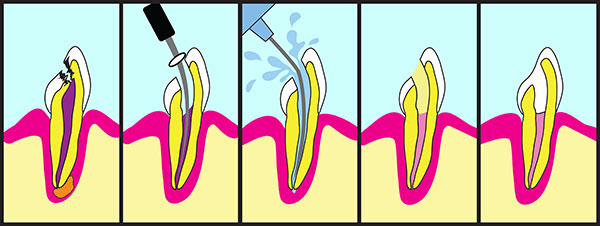What is a Root Canal?
A “root canal” actually refers to the anatomy of a tooth. A tooth is like an iceberg, there is a crown on top that comprises about 1/3 of the tooth length, and the root portion below that comprises the remaining 2/3. Inside the root is a canal that houses the blood supply and nerves of the tooth, which is called the pulp. Essentially, this pulp is what keeps the tooth vital and in good health. It is within this canal that infection can occur. A root canal treatment is recommended to save a compromised tooth from needing extraction, which can happen when the pulp is damaged, and bacteria enter. A tooth can still be functional after the pulp is removed for a root canal treatment, but will lack some sensory effects such as hot and cold sensitivity.
When a Root Canal Treatment is Needed
Several factors dictate the need for a root canal treatment including deep cavities that enter the nerve, trauma to the tooth, chips/fractures or repeated restorative dental work. Often an infected root canal will have symptoms. These symptoms can range from mild cold or hot sensitivity to unbearable throbbing pain. Also, the presence of an infection is common in the form of an abscess. An abscess occurs when the infection from the tooth causes pus to pool at the bottom of the root. Sometimes there can be a “pimple” on the gum that drains the infection. An abscess can be associated with a bad taste.
The process of a Root Canal Treatment

A root canal treatment can take anywhere from 1 to several visits depending on the tooth, size and amount of infection. Molars have more root canals (up to 4 or 5) than front teeth (usually 1.) Either a dentist or an endodontist will perform the procedure depending on the complexity and the difficulty level. If needed, a dentist can refer a patient out to an endodontist. The first step is to take an x-ray of the area to assess the infection. Next, the area will be frozen, and a dental dam will be placed on the tooth to isolate all saliva and bacteria. An access hole will be drilled into the tooth to access the root(s.) The nerve, blood supply and infection will be removed, and the canal will be thoroughly cleaned with files increasing in size. Either on the same day or at a second appointment a week or so later, a filling material will be fitted into the canal(s.) A filling will be placed on top of the canals to seal them off. The last step is the restoration of the crown of the tooth. Usually, a dental crown is recommended to provide support and prevention from chips/fractures.
If you believe you may require a root canal treatment, or have any questions about it, we encourage you to contact us today to schedule an appointment.

